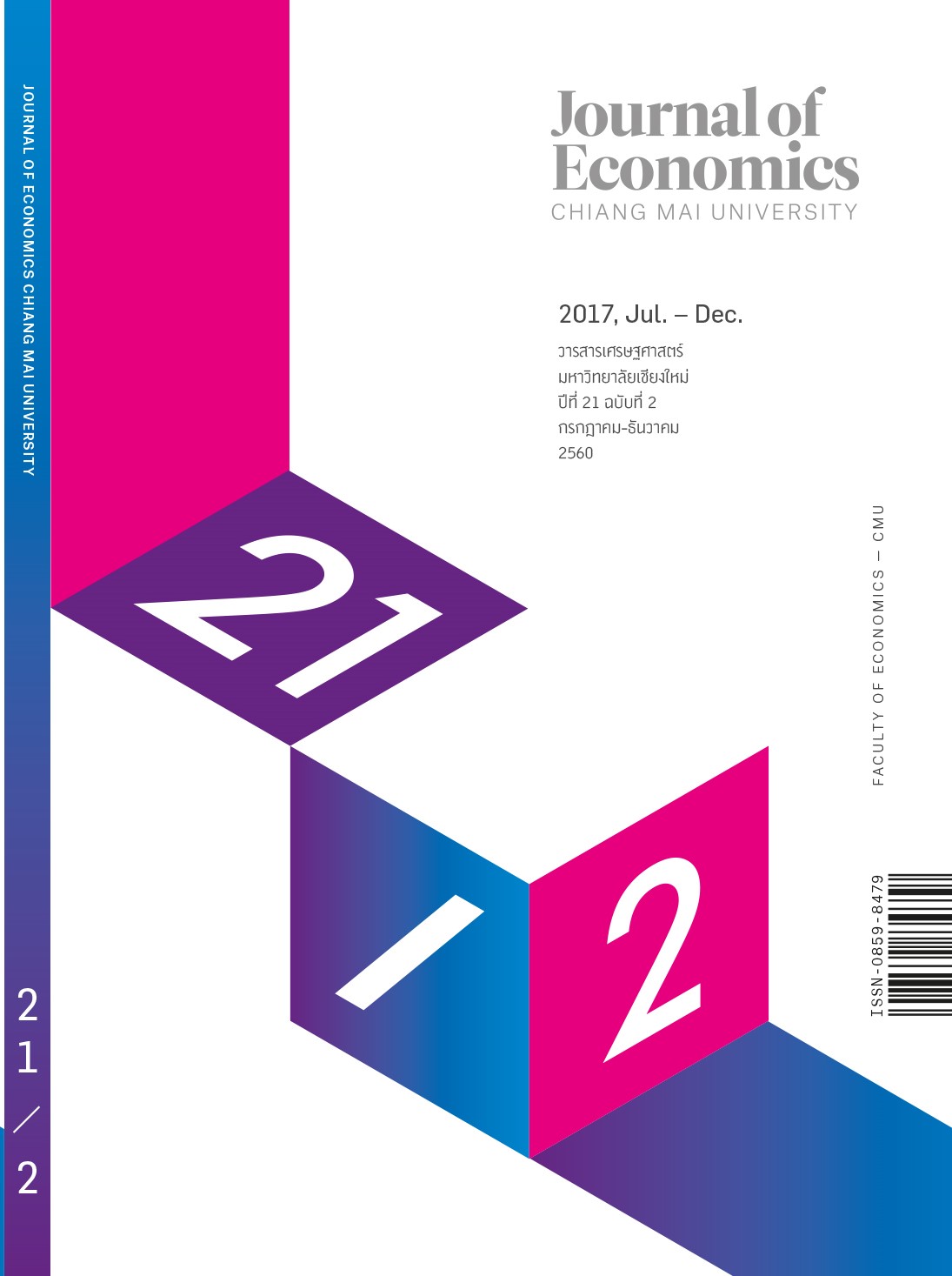การเลือกอัตลักษณ์ของสินค้าชุมชนเพื่อตอบสนองความต้องการของ ตลาดท่องเที่ยวในอำเภอแม่แตง จังหวัดเชียงใหม่
Identity Selection of Community Product for Tourism Market Demand Responsiveness in Mae Tang District, Chiang Mai Province
Keywords:
identity selection, community products, tourism market, two-stage analytical hierarchy process, multinomial logit model, การเลือกอัตลักษณ์, สินค้าชุมชน, ตลาดท่องเที่ยว, กระบวนการวิเคราะห์ตามลำดับชั้นแบบสองขั้นตอน, แบบจําลองโลจิตหลายทางเลือกAbstract
Abstract
This paper aims to 1) investigate local identity for developing community products through the two-stage analytical hierarchy process and 2) analyze factors determining the product purchasing characterizing local identity in Mae Tang District, Chiang Mai Province by using multinomial logit model. The result shows that the top three priorities of local identities selected for tourism product development are Mae Taman Elephant Camp, Wat Ban Den Sa-ree Sri Muang Gaen, and Natural Brown Rice, respectively. Moreover, the factors influencing on the purchasing among three types of community products are different. The findings bring about three target markets including 1) the niche market of health conscious people and nature lovers for community products representing Natural Brown Rice, 2) the elderly person market for community products representing Wat Ban Den Sa-ree Sri Muang Gaen, and 3) market for children, youth and working age people for community products representing Mae Taman Elephant Camp.
Keywords: identity selection, community products, tourism market, two-stage analytical hierarchy process, multinomial logit model
JEL Classification Codes: C01, M21, Z33
บทคัดย่อ
การวิจัยนี้มีวัตถุประสงค์เพื่อ 1) ค้นหาอัตลักษณ์ชุมชนสำหรับพัฒนาสินค้าชุมชนผ่านกระบวนการวิเคราะห์ตามลำดับชั้นแบบสองขั้นตอน และ 2) วิเคราะห์ปัจจัยที่เป็นตัวกำหนดการเลือกซื้อสินค้าที่แสดงถึงอัตลักษณ์ชุมชนในอำเภอแม่แตง จังหวัดเชียงใหม่ โดยใช้แบบจําลองโลจิตหลายทางเลือก ผลการวิจัย พบว่า อัตลักษณ์ชุมชนที่มีความสำคัญสามอันดับแรกที่ถูกเลือกมาสำหรับพัฒนาสินค้าเพื่อการท่องเที่ยว ได้แก่ ปางช้างแม่ตะมาน วัดบ้านเด่นสะหรีศรีเมืองแกน และข้าวกล้องแบบธรรมชาติ ตามลำดับ นอกจากนี้ปัจจัยที่มีอิทธิพลต่อการซื้อสินค้าชุมชนทั้งสามประเภทมีความแตกต่างกันไป ผลการวิจัยสามารถแบ่งตลาดเป้าหมายเป็นสามกลุ่ม ได้แก่ 1) ตลาดเฉพาะของผู้ที่ใส่ใจในสุขภาพและรักธรรมชาติสำหรับสินค้าชุมชนที่แสดงถึงข้าวกล้องธรรมชาติ 2) ตลาดผู้สูงอายุสำหรับสินค้าชุมชนที่แสดงถึงวัดบ้านเด่นสะหรีศรีเมืองแกน และ 3) ตลาดสำหรับกลุ่มเด็ก เยาวชน และคนวัยทำงาน สำหรับสินค้าชุมชนที่แสดงถึงปางช้างแม่ตะมาน
คำสำคัญ: การเลือกอัตลักษณ์ สินค้าชุมชน ตลาดท่องเที่ยว กระบวนการวิเคราะห์ตามลำดับชั้นแบบสองขั้นตอน แบบจําลองโลจิตหลายทางเลือก
JEL Classification Codes: C01, M21, Z33
References
Boissevain, J. (1996). Coping with Tourists: European Reactions to Mass Tourism. Providence: Berghahn Books.
Chambers, E. (1997). Tourism and Culture. An Applied Perspective. New York: State University of New York Press.
Dong, Q., & Cooper, O. (2016). A Peer-to-peer dynamic adaptive consensus reaching model for the group AHP decision making. European Journal of Operational Research 250(2), 521-530.
Dyer, J.S. (1990). Remarks on the analytic hierarchy process. Management Science, 36(3), 249-258.
Ghodeswar, B.M. (2008). Building brand identity in competitive markets: a conceptual model. Journal of Product & Brand Management, 17(1), 4-12.
Ghodsypour, S.H., & O’Brien, C. (1998). A Decision support system for supplier selection using an integrated analytic hierarchy process and linear programming, International Journal of Production Economics, 56: 199-212.
Green, W.H. (2003). Econometric Analysis. 5th ed. Englewood Cliffs: Prentice Hall.
Ho, W., Bennett, D.J., Mak, K.L., Chuah, K.B., Lee, C.K.M., & Hall, M.J. (2009). Strategic logistics outsourcing: an integrated QFD and AHP approach. Industrial Engineering and Engineering Management, 39(12), 10841-10850.
Howell, B. (1994). Weighting the risk and rewards of involvement in cultural conservation and heritage tourism. Human Organization, 53(2), 150-159.
Karanik, M., Wanderer, L., Gomez-Ruiz, J.A., & Pelaez, J.I. (2016). Reconstruction methods for AHP pairwise matrices: how reliable are they?. Applied Mathematics and Computation, 279, 103-124.
Rogers, S. (2002). Which heritage? Nature, culture and identity in French rural tourism. French Historical Studies, 25(3), 475-503.
Saaty, T.L. (1980). The Analytic Hierarchy Process: Planning, Priority Setting, Resource Allocation. New York: McGraw-Hill.
______. (1990). How to make a decision: the analytic hierarchy process. European Journal of Operational Research, 48, 9-26.
______. (2008). Decision making with the analytic hierarchy process. International Journal Services Sciences, 1(1), 83-98.
Suriya, K. (2009). Logit model: theory and application in economics research method. Chiang Mai: Faculty of Economics, Chiang Mai University. Retrieved October 21, 2015, from http://www.tourismlogistics.com. (in Thai).
Wiboonpongse, A. (2006). Applied econometrics for agricultural marketing. Chiang Mai: Faculty of Agriculture, Chiang Mai University. (in Thai).
Zhu, X., and Dale, A.P. (2001). Identifying opportunities for decision support systems in support of regional resource use planning: an approach through soft systems methodology. Environmental Management, 16, 251-262.
Downloads
Published
Issue
Section
License
All opinions and contents in the CMJE are the responsibility of the author(s). Chiang Mai University Journal of Economics reserves the copyright for all published materials. Papers may not be reproduced in any form without the written permission from Chiang Mai University Journal of Economics.
ข้อคิดเห็นที่ปรากฏและแสดงในเนื้อหาบทความต่างๆในวารสารเศรษฐศาสตร์มหาวิทยาลัยเชียงใหม่ ถือเป็นความเห็นและความรับผิดชอบโดยตรงของผู้เขียนบทความนั้นๆ มิใช่เป็นความเห็นและความรับผิดชอบใดๆของวารสารเศรษฐศาสตร์ มหาวิทยาลัยเชียงใหม่
บทความ เนื้อหา และข้อมูล ฯลฯ ในวารสารเศรษฐศาสตร์มหาวิทยาลัยเชียงใหม่ ถือเป็นลิขสิทธิ์เฉพาะของคณะเศรษฐศาสตร์มหาวิทยาลัยเชียงใหม่ หากบุคคลหรือหน่วยงานใดต้องการนำทั้งหมดหรือส่วนหนึ่งส่วนใดไปเผยแพร่ต่อหรือเพื่อกระทำการใดๆ จะต้องได้รับอนุญาตเป็นลายลักษณ์อักษร จากวารสารเศรษฐศาสตร์ มหาวิทยาลัยเชียงใหม่






